Building Camp Dix - 1917
A photographic exhibit documenting the monumental tasks involved in building a World War 1 Army cantonment during 1917 near Wrightstown, New Jersey, a borough in Burlington County. Camp Dix was later renamed Fort Dix - a Joint Base McGuire-Dix-Lakehurst Army post.
- Brief History of the Building of Camp Dix
- The Building Phase
- Commanding Officers
- Views of the Camp During Construction
- Camp Under Construction
- Kitchen and Cafeteria Facilities
- Raising the Barracks
- Camp Dix Water Supply System
- How to Build a Barrack
- The Builders of the Camp
The Building of Camp Dix
Before the eventful month of June 1917, few people of the outside world, or even of New Jersey itself, had heard of Wrightstown. Or, if the name was at all familiar, it was because they had lost their way while motoring and gone far from the main highways.
It was merely one of the hundreds of obscure New Jersey villages which had neither flourished nor declined materially since the days when Washington crossed the Delaware River.
The marl region's fertile soil had proved so valuable for farming that the natives had preferred the peaceful occupation of growing wheat and corn for the New York markets to the industries with which large numbers of workers are associated.
And so Wrightstown had "stayed put"; had it not been for the aberration of the German Empire, it would still be "put," and its calm, monotonous existence would not have been disturbed.
But when, early in June, the government agents, after riding many miles through that agricultural region, interspersed here and there by pine forests, came to Wrightstown, they put their heads together and nodded approvingly.
Here was a possible site for a camp, neither too far from the great centers for obtaining the necessary supplies nor within objectionable proximity to the cities.
The climate was ideal; the surroundings and natural advantages were incomparable. And so the lamp of Aladdin was rubbed, and the genie was summoned to begin his work.
The contract for the construction of the camp was awarded to the Irwin and Leighton Company of Philadelphia, and immediately the great task was begun. About two hundred people, farmers, for the most part, lived on the four thousand acres which were apportioned to Camp Dix.
As corn and wheat fields were ripening for the harvest, some of the farmers were reluctant to give their land at first. But the military authorities were liberal with them; they explained the necessity of the property for the draft men's training and eventually persuaded the natives to leave their homesteads without compulsion.
The great fields of crops soon fell to the hands of the engineers and workmen. Major H. C. Williams was the constructing quartermaster, and Major T. A. Reimer represented the government. Sixty men were detailed from the First Battalion, New Jersey Engineers, to assist the contractors.
The fields were leveled, the woods and underbrush removed, the stumps cleared, the swamp-land drained. By July 1, several thousand workmen were busy erecting buildings, laying sewer and water pipes, building roads, preparing in every way for the inpouring of the forty thousand draft men who were to come.
Not only were sleeping quarters necessary for this large population, but also every provision for health, sanitation, expediency, and comfort had to be provided.
Like every model city, Camp Dix must have running water in every building, a perfect sewerage system, an up-to-date hospital, telephones, electric lights, heating arrangements — in short, every municipal necessity and convenience.
The contractors did not have unlimited time for this colossal task; it had to be completed in three months. The company issued the Camp Dix News to stimulate interest among the workmen and impart their task's patriotic value.
The Camp newspaper published everything that might interest the men and spur them on. Figures and tables were given, showing the work which had been accomplished, and that which still had to be done.
By the end of August, when the camp was nearing completion, about fifteen thousand men were working night and day in a final effort to get the city ready for its forty thousand inhabitants.
Early in September 1917, the first draft men arrived; the flow continued steadily until December when the capacity of forty-two thousand men was reached. Of these, upstate New York and New Jersey each sent about twenty thousand men, and Delaware's Camp Dix quota was twelve hundred.
The cantonment was christened Camp Dix by the War Department in honor of General John A. Dix, who, as Secretary of the Treasury. In the last days of President Buchanan's administration, issued, January 29, 1861, to a revenue officer at New Orleans, the famous order which contained the words " if anyone attempts to haul down the American flag, shoot him on the spot," and who afterwards became a major-general of volunteers in the Civil War.
The original Camp Dix unit was designated the 78th Division, commanded by Major-General Hugh L. Scott. General Scott has a long war record, beginning in 1876 when he graduated from the Military Academy.
He has been engaged in many Indian wars and was adjutant-general in Cuba at the time of the Spanish-American War. In 1906, he became commandant of West Point.
In November 1914, he became Chief of Staff, and since that time has done much work of a diplomatic character, particularly among the unruly Indians. General Scott took command of the division in January 1918.
The principal units of the 78th Division, the first division assigned to Camp Dix, were:
- Infantry: 309th, 310th, 311th, 312th Regiments.
- Field Artillery: 307th, 308th, 309th Regiments.
- Machine Gun Battalions: 308th, 309th.
- 153rd Depot Brigade.
- 303rd Engineers.
- 303rd Headquarters Train and Military Police.
- 303rd Trench Mortar Battery.
- 303rd Field Signal Battalion.
- Medical Corps
From the very first there has been no doubt of the success of Camp Dix from a military point of view. It is hard to understand how, in six short months, men of every nationality, sect, and station of life were welded into an efficient fighting unit, but that wonder was accomplished.
Those who came to Dix in the fall of 1917 were regarded as veterans by the later arrivals. And so it will be as long as Camp Dix remains, as long as the spirit of to-day lives.
It could not have been accomplished unless every officer and man had done his best. That is the secret, the only secret of success — the American fighting spirit.
This book is intended for the boys of Camp Dix, and for their families and friends. As the soldiers of to-day go overseas, they may sometimes turn its pages for a glimpse of their earlier training ground.
And in later years, when their service is but a memory, they may recall the scenes they knew so well with a touch of pride and pleasure. Their families and friends may now see Camp Dix intimately, its men at work and at play, and may then understand better what it all means.
I wish to express my indebtedness to Mr. C. Albert Kuehnle and Mr. Thomas R. Null of Philadelphia, who aided me greatly in preparing this volume, and also to the officers and men of Camp Dix, whose cooperation and courtesy I much appreciate. Roger Batchelder (Note 1)
The Building Phase
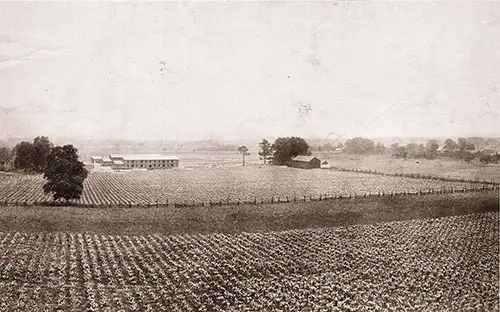
Photograph 01-01: From Fertile Farms to Serried Rows of Barracks in Less than Sixty Days. View taken from the Tower July 17, 1917. Camp Dix Pictorial Review, November 1917. GGA Image ID #
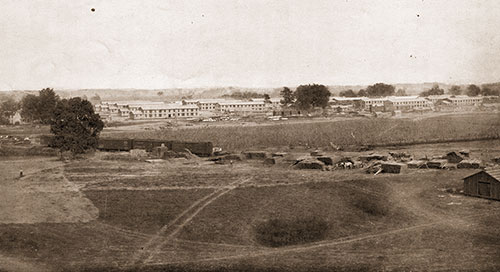
Photograph 01-02: View taken from the Tower September 18, 1917. Camp Dix Pictorial Review, November 1917. | GGA Image ID #
Commanding Officers
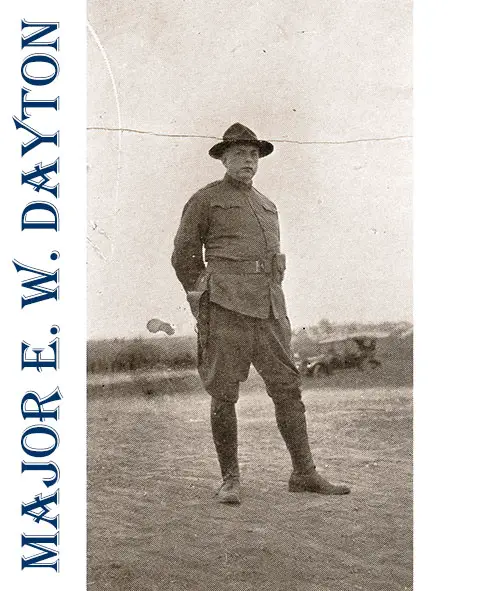
Photograph 02-01: Major E. W. Dayton, 15th N. Y. Infantry. Camp Dix Pictorial Review, November 1917. | GGA Image ID #
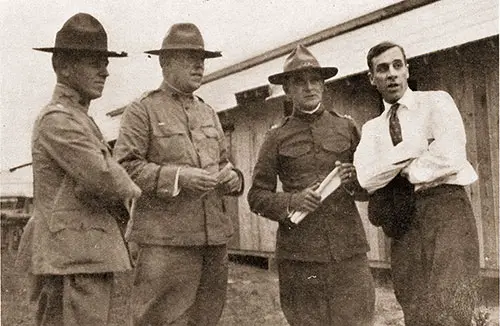
Photograph 02-02: General Kennedy Looking Over the Camp from the High Ground at Division Headquarters on the Day of His Arrival.Left to right: Lieutenant Colonel G. Soulard Turner, Acting Adjutant; Major General Chase W. Kennedy, Commanding General; Captain Theodore H. Skinner, Constructing Quartermaster; E. M. Campbell, in Charge for the Contractors. Camp Dix Pictorial Review, November 1917. | GGA Image ID #
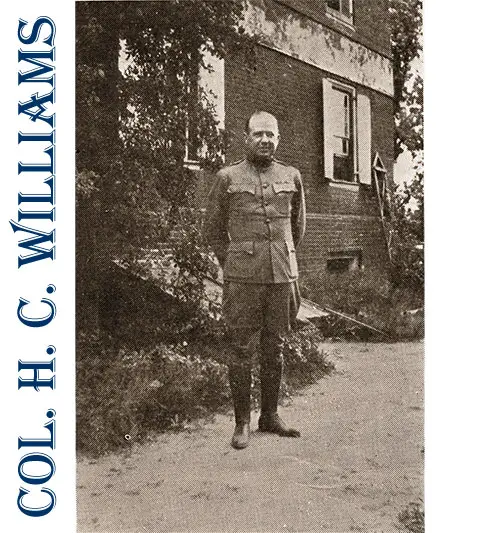
Photograph 02-03: Colonel H. C. Williams. Constructing Quartermaster of Camp Dix from the beginning until August 31, 1917. Camp Dix Pictorial Review, November 1917. | GGA Image ID #
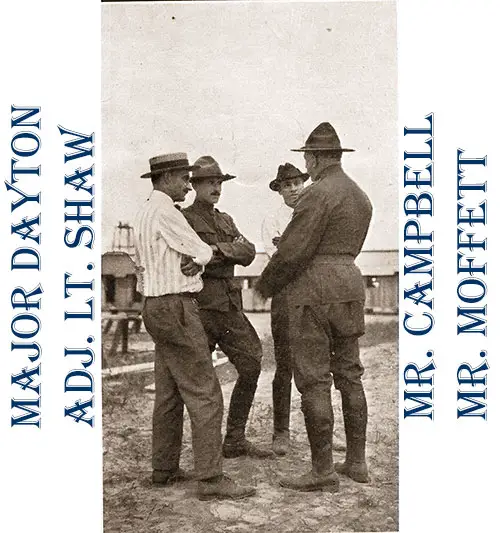
Photograph 02-04: Major Dayton and Adj. Lt. Shaw chatting with Messrs. Campbell and Moffett. Camp Dix Pictorial Review, November 1917. | GGA Image ID #
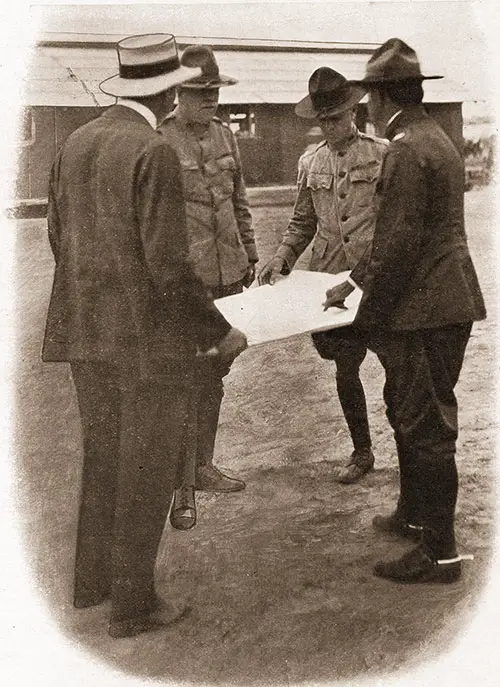
Photograph 02-05: On the Day Major General Kennedy Arrived in Camp Dix, August 30, 1917 -- Looking at a Map of the Camp.
Facing forward, left -- Major General Chase W. Kennedy, Commanding General of Camp Dix, and Lieutenant Colonel G. Soulard Turner, Acting Adjutant. Facing forward, right -- Captain Theodore Skinner, Constructing Quartermaster (pointing to a location), and Joseph F. Lynch, General Superintendent of Construction (in civilian dress). Camp Dix Pictorial Review, November 1917. | GGA Image ID #
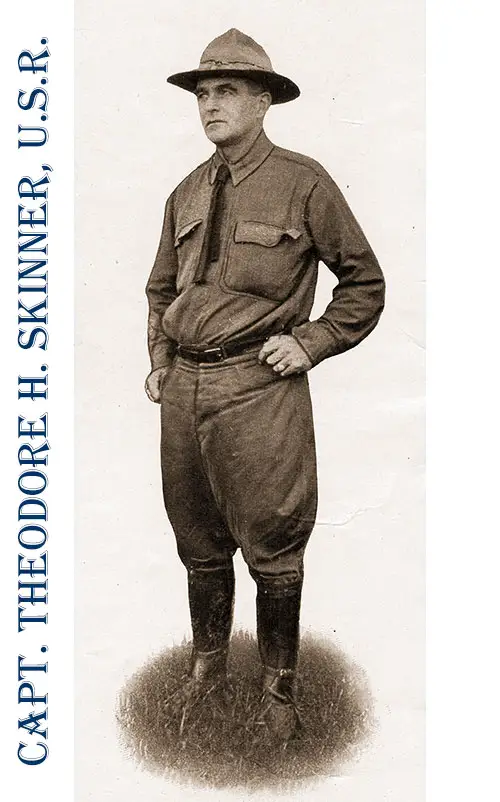
Photograph 02-06 Captain Theodore H. Skinner, U.S.R. - Constructing Quartermaster of Camp Dix from August 31, 1917, until its completion. Camp Dix Pictorial Review, November 1917. | GGA Image ID #
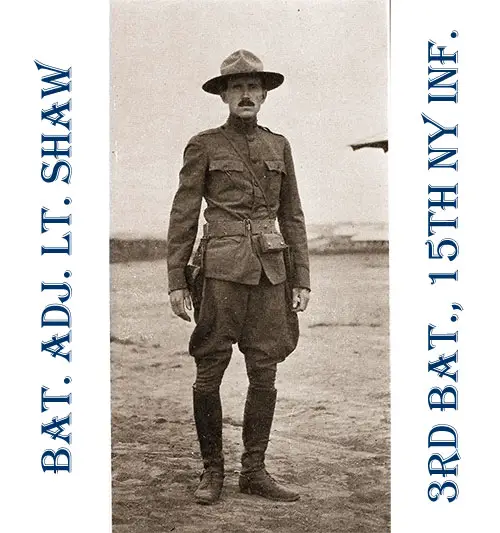
Photograph 02-07: Bat. Adj. Lt. Lewis E. Shaw, 3rd Bat., 15th N. Y. Infantry. Camp Dix Pictorial Review, November 1917. | GGA Image ID #

Photograph 02-08: 78th Division Headquarters Situated at the end of the Parade Ground, on the highest level of the Camp, it commands a view of the two-mile-long Parade Ground from end to end. It is 175 feet above sea level. Camp Dix Pictorial Review, November 1917. | GGA Image ID #
Views of the Camp During Construction
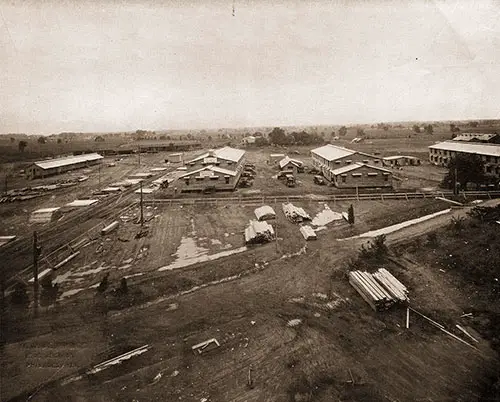
Photograph 03-01: Main Camp Dix Irwin & Leighton Field Office is Now 167-Men Barracks (As it appeared August 3, 1917). Camp Dix Pictorial Review, November 1917. | GGA Image ID #
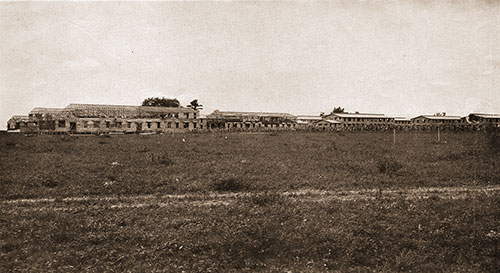
Photograph 03-02: Part of Camp Dix in Course of Erection - Section 3, Not flies in the foreground, but a group of men (on August 3, 1917). Camp Dix Pictorial Review, November 1917. | GGA Image ID #
Camp Under Construction
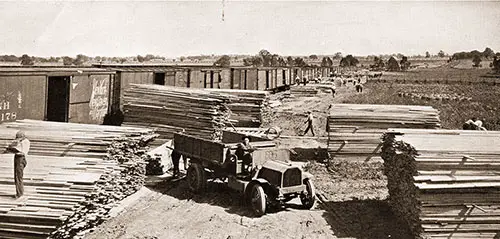
The Arrival of Part of the Forty Million Feet of Lumber Used in the Construction of Camp Dix. Camp Dix Pictorial Review, November 1917. | GGA Image ID #
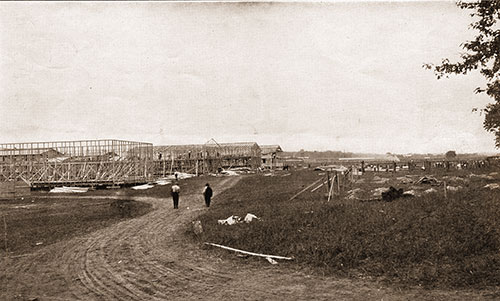
The Lumber shown in previous picture is brought by rail to where needed and in a few days covers these skeletons (taken August 5, 1917). Camp Dix Pictorial Review, November 1917. | GGA Image ID #

Showing a row of one-story Officers' Quarters. Camp Dix Pictorial Review, November 1917. | GGA Image ID #
Kitchen and Cafeteria Facilities
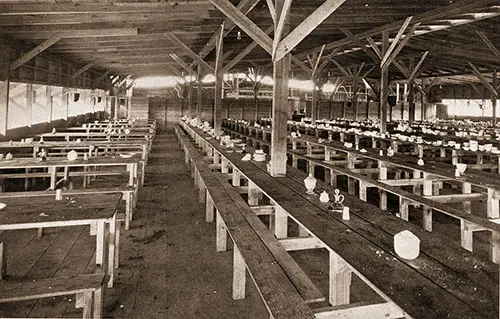
Photograph 05-01: Interior view of a cafeteria that seats 1,500 of the Contractors' workmen. Camp Dix Pictorial Review, November 1917. | GGA Image ID #
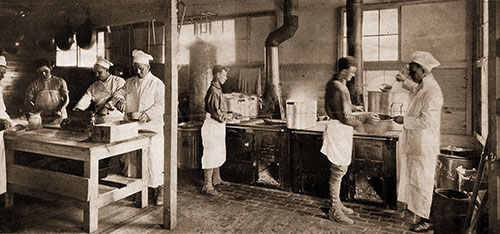
Photograph 05-02: An Army barrack kitchen provides meals for 250 men -- Note the Dainty Fudge Aprons. Camp Dix Pictorial Review, November 1917. | GGA Image ID #

Photograph 05-03: Panoramic View of Camp Dix. Camp Dix Pictorial Review, November 1917. | GGA Image ID #
Raising the Barracks
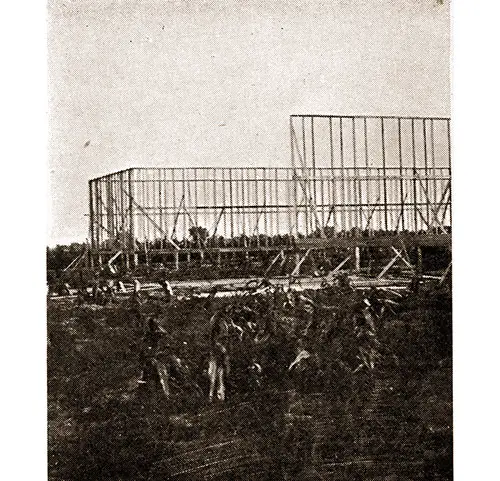
Photograph 06-01: 15:00 Hours: No. 1 - The end-framing wall is lying on the ground. Camp Dix Pictorial Review, November 1917. | GGA Image ID #
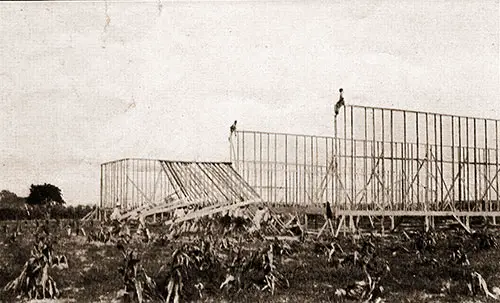
Photograph 06-02: 15:02 Hours: No. 2 - Two men are climbing the corner posts. Camp Dix Pictorial Review, November 1917. | GGA Image ID #
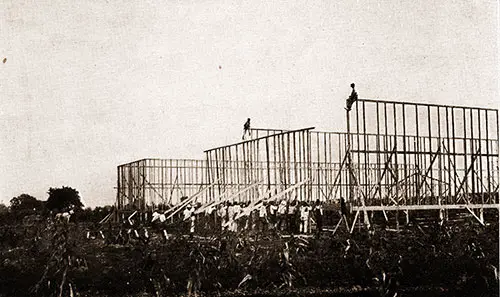
Photograph 06-03: 15:04 Hours: No. 3 - The end-wall framing is gradually going up. Camp Dix Pictorial Review, November 1917. | GGA Image ID #
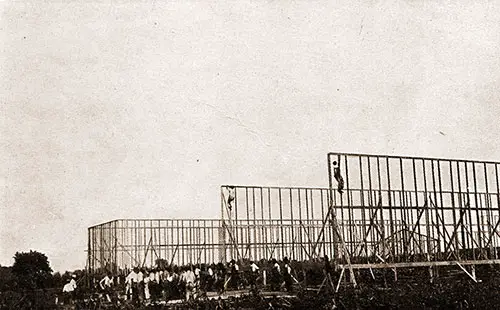
Photograph 06-04: 15:14 Hours: No. 4 - The end-wall framing is nearing its position. Camp Dix Pictorial Review, November 1917. | GGA Image ID #
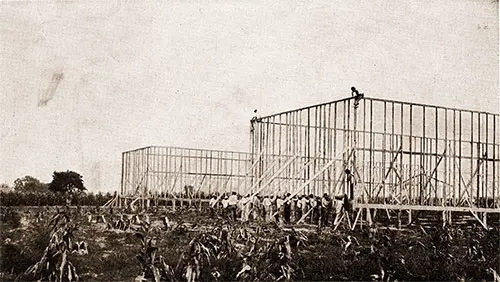
Photograph 06-05: 15:15 Hours: No. 5 - The two men are nailing it to the side-wall framing. Camp Dix Pictorial Review, November 1917. | GGA Image ID #
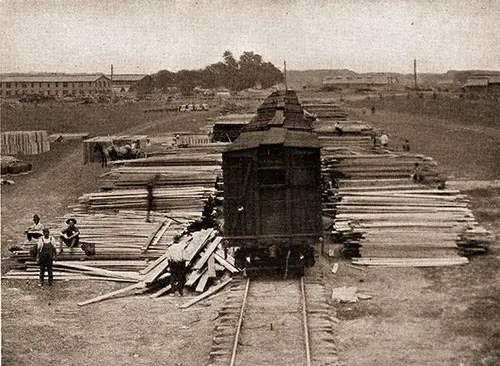
Photograph 06-06: Unloading Lumber within a few feet of where it goes into building one of Camp Dix's many structures . For buildings further away from the rails, the lumber would be loaded onto wagons and pulled by horses to the new building's intended location within the camp. See How to Build a Barrack for additional photographs and information about this process. Camp Dix Pictorial Review, November 1917. | GGA Image ID #
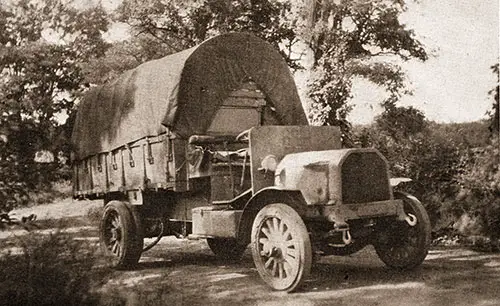
Photograph 06-07: Not "Somewhere in France" - But en route between Camp Dix and Philadelphia, bringing in a load of fresh provisions. Camp Dix Pictorial Review, November 1917. | GGA Image ID #
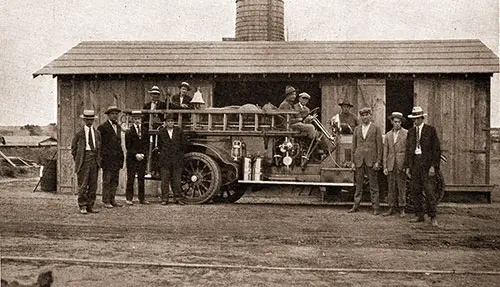
Photograph 06-08: Fire Protection at Camp Dix - One of the three latest type motor engines. Camp Dix Pictorial Review, November 1917. | GGA Image ID #
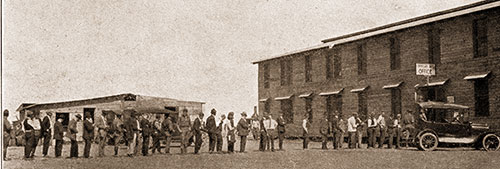
Photograph 06-09: The Cafeteria Located in Section 7 - At which the contractors' and government clerks, timekeepers and other office men ate their meals. Owing to the noon rush, a line was usually formed about 12 Noon. Camp Dix Pictorial Review, November 1917. | GGA Image ID #
Camp Dix Water Supply System
The picture (07-01 below) is that of the Camp Dix water supply station taken a few days before the building was finished. One turbine and pump unit had already been installed and was then in operation.
A supply of water, estimated at 15,000,000 gallons daily, flows through the north branch of the Rancocas Creek, on which it is situated. Experiments in artesian well-driving indicate that subterranean water can be obtained in sufficient quantities and the surface water used only for an emergency.
The water obtained from the creek is filtered through miles of sandy soil, characteristic of the pine section of New Jersey in which it originates. There is also a considerable percentage of cedar growing in the watershed, and the water, coming in contact with fallen needles and cedar roots, is given a slight amber tinge and an almost imperceptible taste of cedar.
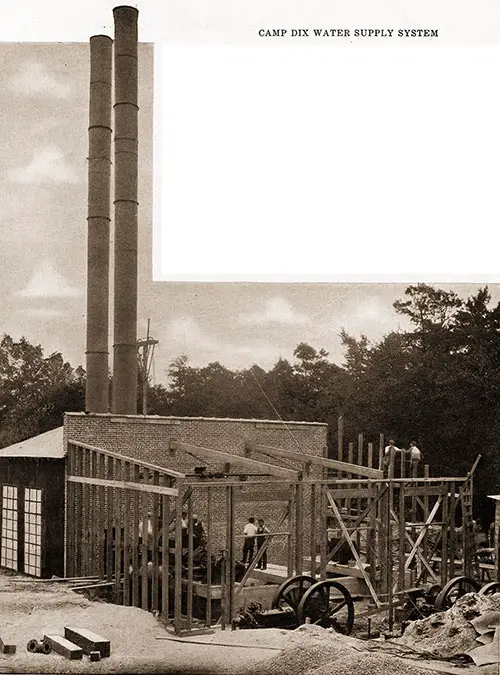
Photograph 07-01: Camp Dix pumping Station at New Lisbon, New Jersey. From here it is pumped three miles through a 16-inch main. Camp Dix Pictorial Review, November 1917. | GGA Image ID #
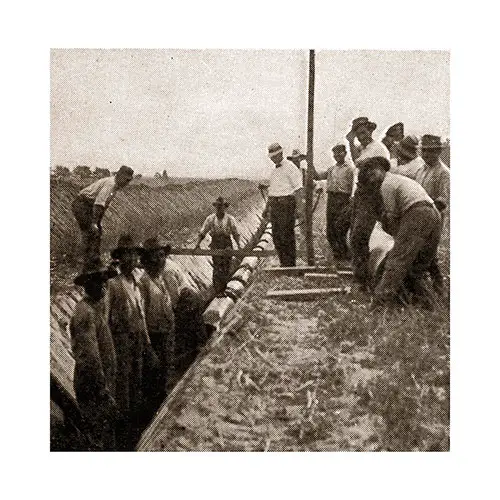
Photograph 07-02: Putting down a section of big pipe. Camp Dix Pictorial Review, November 1917. | GGA Image ID #
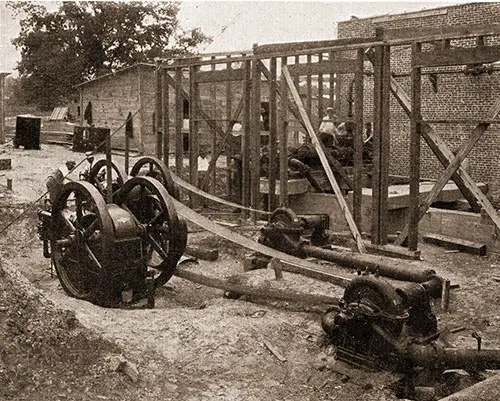
Photograph 07-03: Water Entering Camp Dix - One thousand tons of 16-inch iron pipe were hauled for this water main. Camp Dix Pictorial Review, November 1917. | GGA Image ID #
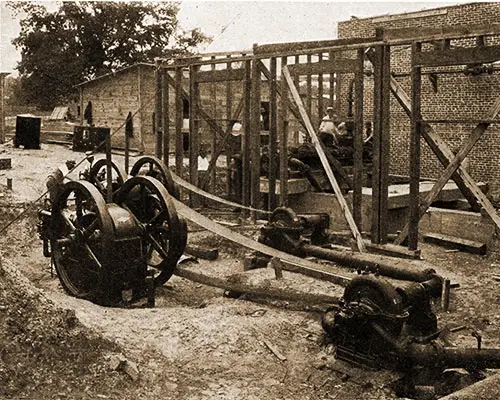
Photograph 07-04: The Temporary Water Pump and Engine
How to Build A Barrack:
Result of One Day's Work - A Barrack Started and Finished in a span of Ten Hours
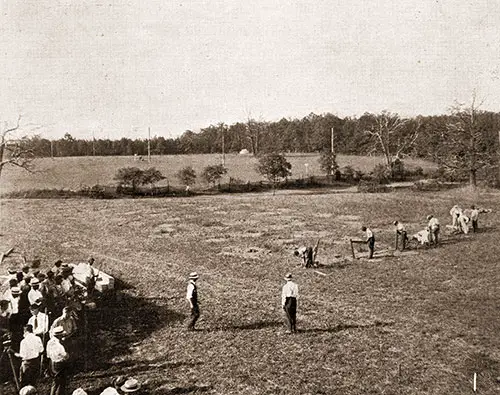
Photograph 08-01: Step 1. Laying out building lines. Camp Dix Pictorial Review, November 1917. | GGA Image ID #
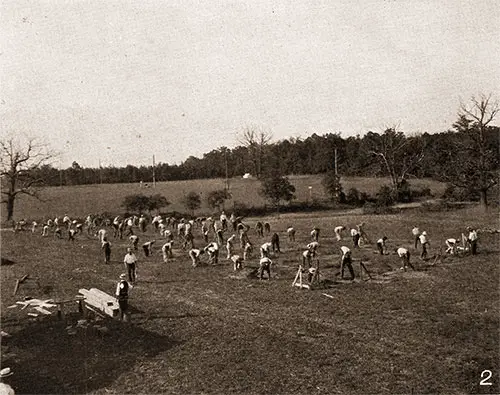
Photograph 08-02: Step 2. Excavating for post foundations. Camp Dix Pictorial Review, November 1917. | GGA Image ID #
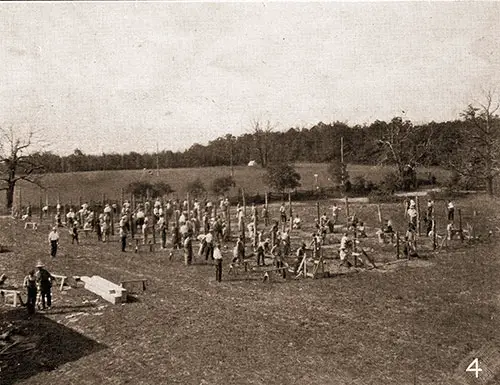
Photograph 08-03: Step 3. Carrying and setting post foundations. Camp Dix Pictorial Review, November 1917. | GGA Image ID #
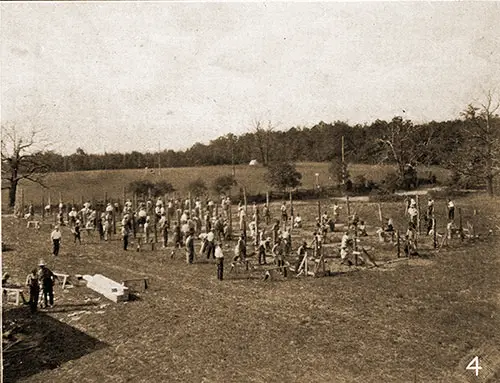
Photograph 08-04: Step 4. Cutting off foundation posts. Camp Dix Pictorial Review, November 1917. | GGA Image ID #
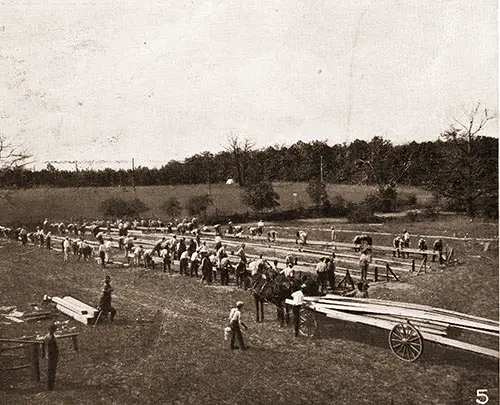
Photograph 08-05: Step 5. Setting sills and girders. Camp Dix Pictorial Review, November 1917. | GGA Image ID #
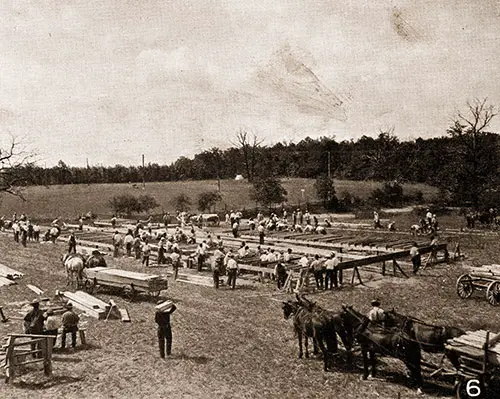
Photograph 08-06: Step 6. Setting first-floor joists. Camp Dix Pictorial Review, November 1917. | GGA Image ID #
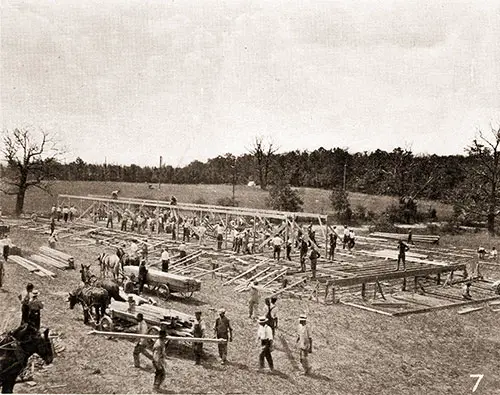
Photograph 09-01: Step 7. Setting first-floor posts and second-floor girders. Camp Dix Pictorial Review, November 1917. | GGA Image ID #
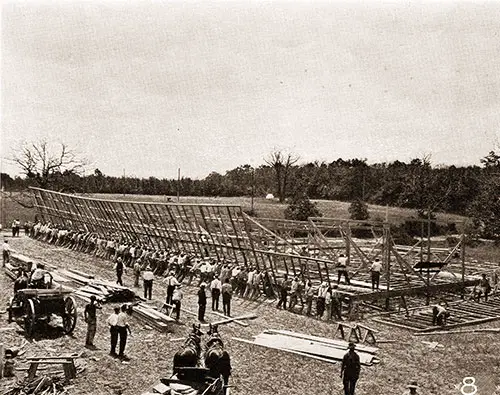
Photograph 09-02: Step 8. Raising side-wall framing. Camp Dix Pictorial Review, November 1917. | GGA Image ID #
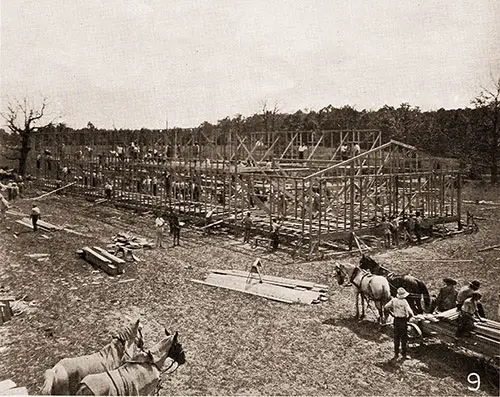
Photograph 09-03: Step 9. Placing second-floor joists. Camp Dix Pictorial Review, November 1917. | GGA Image ID #
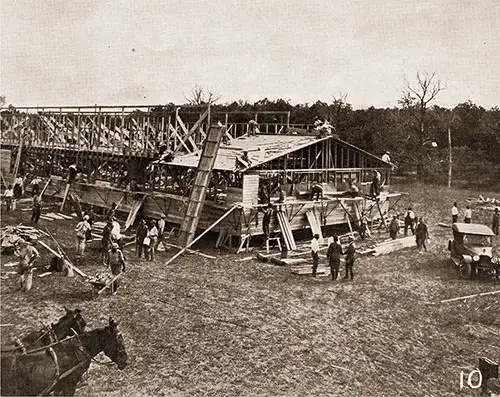
Photograph 09-04: Step 10. Putting on siding and roofing. Camp Dix Pictorial Review, November 1917. | GGA Image ID #
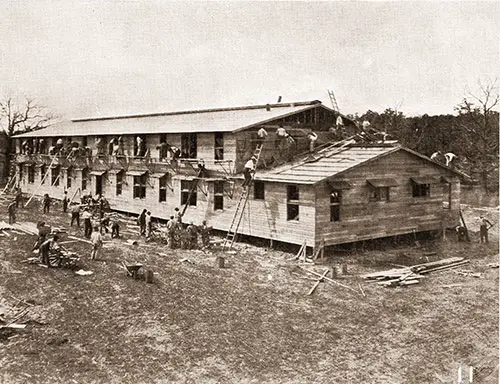
Photograph 09-05: Step 11. Cleaning and finishing up. Camp Dix Pictorial Review, November 1917. | GGA Image ID #
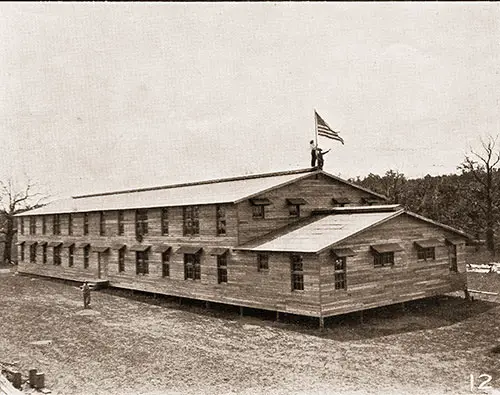
Photograph 09-06: Step 12. Grand Finale. Camp Dix Pictorial Review, November 1917. | GGA Image ID #
The Builders of the Camp
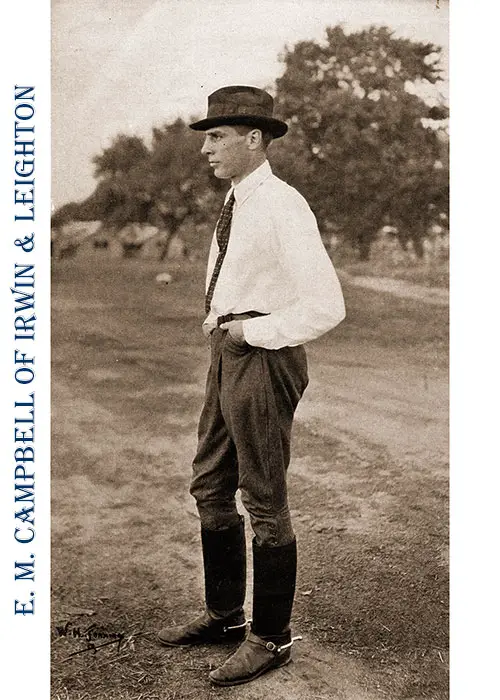
Photograph 10-01: E. M. Campbell - In charge for Irwin & Leighton, the builders. Camp Dix Pictorial Review, November 1917. | GGA Image ID #
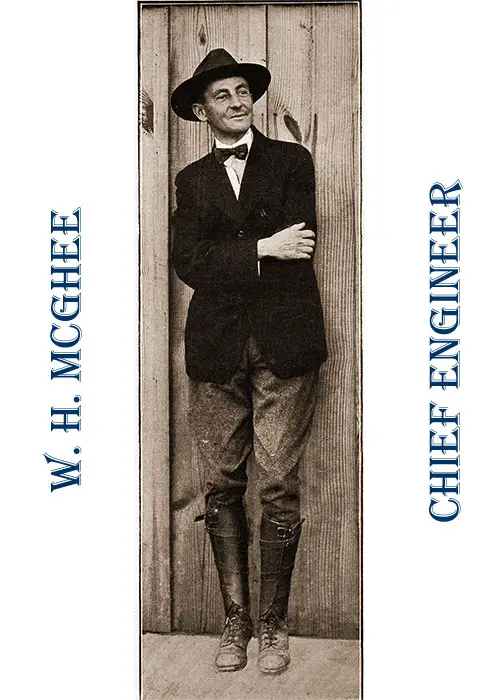
Photograph 10-02: W. B. McGhee - Chief Engineer of the construction of Camp Dix. Camp Dix Pictorial Review, November 1917. | GGA Image ID #
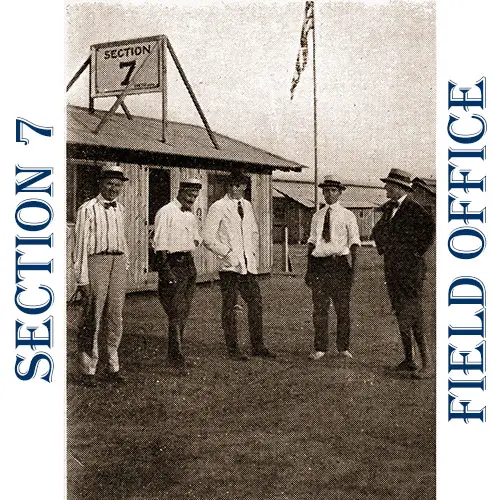
Photograph 10-03: A Section Field Office Where The Men Check In and Out. Eleven of these offices were in operation, also the section superintendent's headquarters. Camp Dix Pictorial Review, November 1917. | GGA Image ID #
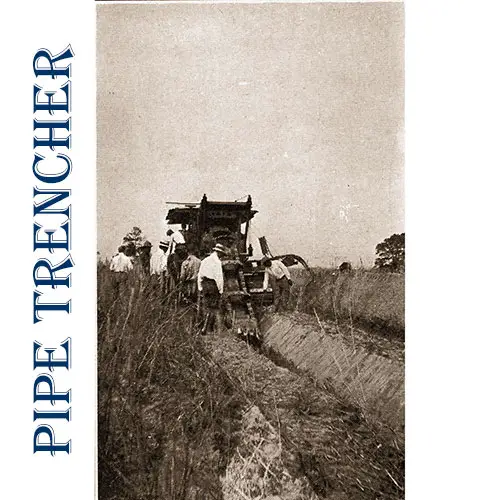
Photograph 10-04: Following a Pipe Trencher. Camp Dix Pictorial Review, November 1917. | GGA Image ID #
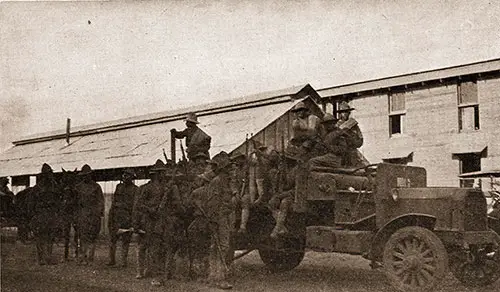
Photograph 10-05: Members of 15th N.Y. Infantry (Colored) Arriving at Camp Dix. Camp Dix Pictorial Review, November 1917. | GGA Image ID #
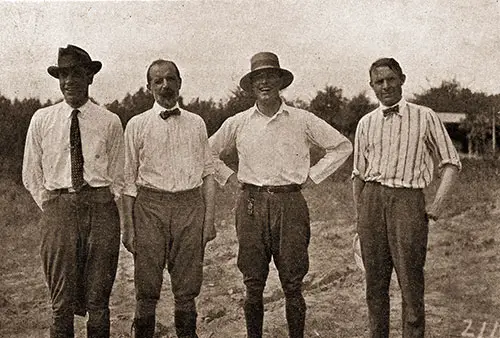
Photograph 10-06: Messrs. Campbell, Rouse, Irwin and Lynch - On a Fine Summer Day. Camp Dix Pictorial Review, November 1917. | GGA Image ID #

Photograph 10-07 (Above) and 10-08 (Below) A Group of Hospital Orderly Barracks Started and completed within Seven Hours -- An Average of One an Hour. Camp Dix Pictorial Review, November 1917. | GGA Image ID #
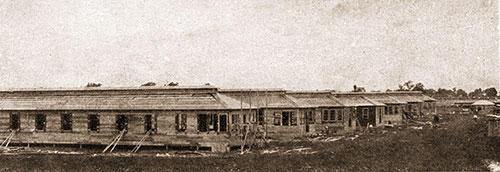
Note 1: Excerpt from "The Building of Camp Dix," in Camp Dix: Described and Photographed by Roger Batchelder, Boston: Small, Maynard & Company, 1918, p. 4-7. Edited by P. K. Gjenvick 2019. Camp Dix Pictorial Review, November 1917. | GGA Image ID #
Photographs from Camp Dix Pictorial Review: A Picture History of a National Army Cantonment, Wrightstown, New Jersey, Vol. 1, No. 1, November 1917.
